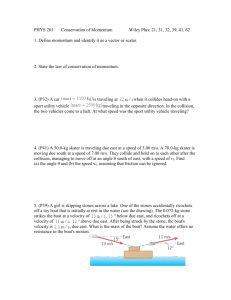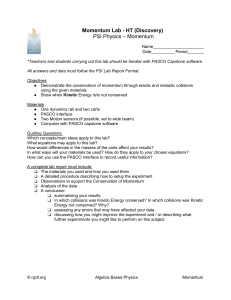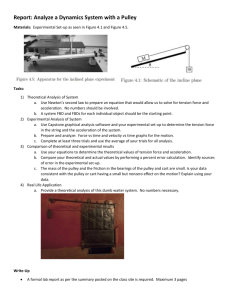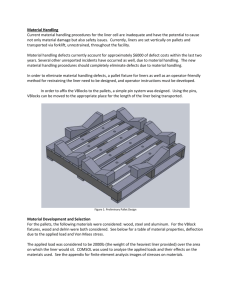HW Solutions MOMENTUM 2015
advertisement
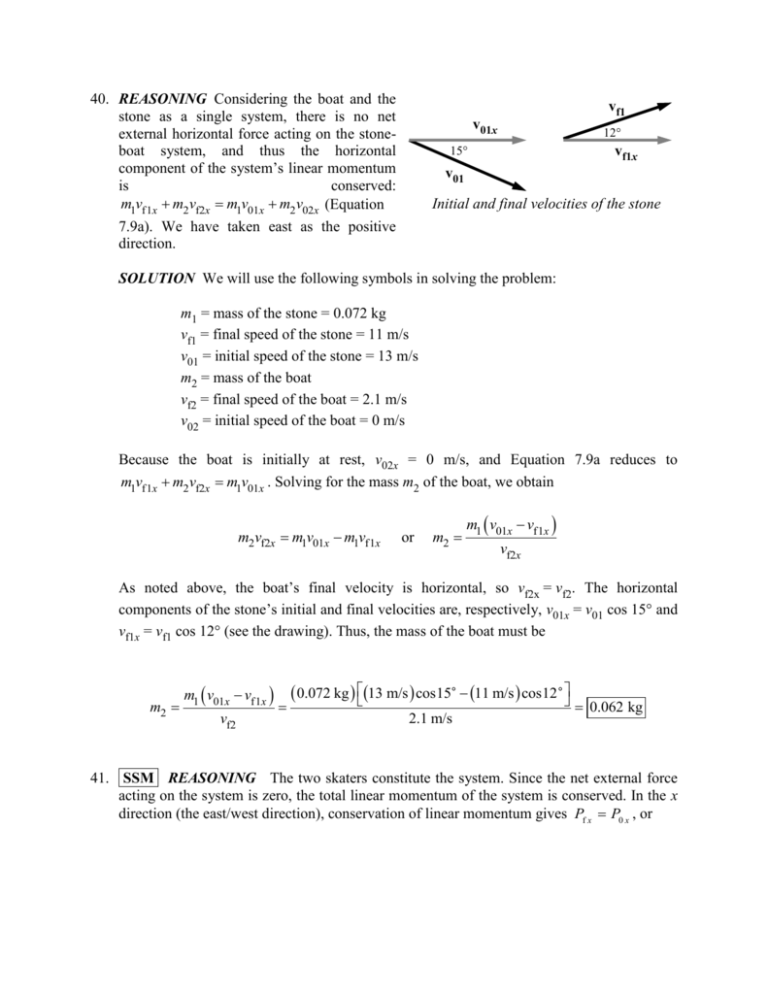
40. REASONING Considering the boat and the stone as a single system, there is no net external horizontal force acting on the stoneboat system, and thus the horizontal component of the system’s linear momentum is conserved: m1vf1x m2vf2x m1v01x m2v02x (Equation 7.9a). We have taken east as the positive direction. vf1 v01x 12° vf1x 15° v01 Initial and final velocities of the stone SOLUTION We will use the following symbols in solving the problem: m1 = mass of the stone = 0.072 kg vf1 = final speed of the stone = 11 m/s v01 = initial speed of the stone = 13 m/s m2 = mass of the boat vf2 = final speed of the boat = 2.1 m/s v02 = initial speed of the boat = 0 m/s Because the boat is initially at rest, v02x = 0 m/s, and Equation 7.9a reduces to m1vf1x m2vf2x m1v01x . Solving for the mass m2 of the boat, we obtain m2vf2x m1v01x m1vf1x or m2 m1 v01x vf1x vf2x As noted above, the boat’s final velocity is horizontal, so vf2x = vf2. The horizontal components of the stone’s initial and final velocities are, respectively, v01x = v01 cos 15° and vf1x = vf1 cos 12° (see the drawing). Thus, the mass of the boat must be m2 m1 v01x vf1x vf2 0.072 kg 13 m/s cos15 11 m/s cos12 2.1 m/s 0.062 kg 41. SSM REASONING The two skaters constitute the system. Since the net external force acting on the system is zero, the total linear momentum of the system is conserved. In the x direction (the east/west direction), conservation of linear momentum gives Pf x P0 x , or ( m1 m2 ) v f cos m1v 01 Note that since the skaters hold onto each other, they move away with a common velocity vf. In the y direction, Pf y P0 y , or ( m1 m2 ) v f sin m2 v 02 These equations can be solved simultaneously to obtain both the angle and the velocity vf. SOLUTION a. Division of the equations above gives tan 1 Fm v I tan L(70.0 kg)(7.00 m / s) O 73.0 G Hm v J K M N(50.0 kg)(3.00 m / s) P Q 2 1 02 1 01 b. Solution of the first of the momentum equations gives vf m1 v 01 ( m1 m2 ) cos (50.0 kg)(3.00 m / s) 4.28 m / s (50.0 kg 70.0 kg)(cos 73.0 ) 42. REASONING +355 m/s a. The conservation of linear Block 1 Block 2 momentum can be applied to this three-object system (the bullet and (a) Before collisions the two blocks), even though the second collision occurs later than the first one. Since there is no vblock 2 +0.550 m/s friction between the blocks and the horizontal surface, air resistance is negligible, and the weight of each mblock 2 = 1530 g mblock 1 = 1150 g block is balanced by a normal mbullet = 4.00 g force, the net external force acting on this system is zero, and the (b) After collisions conservation of linear momentum applies. This principle will allow us to determine the velocity of the second block after the bullet imbeds itself. b. The total kinetic energy of the three-body system is not conserved. Both collisions are inelastic, and the collision with block 2 is completely inelastic since the bullet comes to rest within the block. As with any inelastic collision, the total kinetic energy after the collisions is less than that before the collisions. SOLUTION a. The conservation of linear momentum states that the total momentum of the system after the collisions [see part (b) of the drawing] is equal to that before the collisions [part (a) of the drawing]: mblock 1vblock 1 + mblock 2 + mbullet vblock 2 Total momentum after collisions mbullet vbullet Total momentum before collisions Solving for the velocity vblock 2 of block 2 after the collisions gives vblock 2 mbullet vbullet mblock 1vblock 1 mblock 2 + mbullet 4.00 103 kg 355 m/s 1.150 kg 0.550 m/s 1.530 kg + 4.00 103 kg 0.513 m/s b. The ratio of the total kinetic energy (KE) after the collision to that before the collision is KEafter KE before 1m v2 2 block 1 block 1 1 2 2 mblock 2 + mbullet vblock 2 1m v2 2 bullet bullet 1 2 1.530 kg + 4.00 103 kg 0.513 m/s2 1.49 103 1 4.00 10 3 kg 355 m/s 2 2 1.150 kg 0.550 m/s 2 1 2 EXAM Sample Questions: 3. A stunt person jumps from the roof of a tall building, but no injury occurs because the person lands on a large, air-filled bag. Which one of the following best describes why no injury occurs? A) The bag provides the necessary force to stop the person. B) The bag reduces the impulse to the person. C) The bag increases the amount of time the force acts on the person and reduces the change in momentum. D) The bag decreases the amount of time during which the momentum is changing and reduces the average force on the person. E) The bag increases the amount of time during which the momentum is changing and reduces the average force on the person. Ans: E Difficulty: Hard SectionDef: Section 7-1 7. A 0.2-kg steel ball is dropped straight down onto a hard, horizontal floor and bounces straight up. The ball's speed just before and just after impact with the floor is 10 m/s. Determine the magnitude of the impulse delivered to the floor by the steel ball. A) zero N s B) 2 N s C) 4 N s D) 20 N s E) 200 N s Ans: C Difficulty: Medium SectionDef: Section 7-1 14. The head of a hammer (m = 1.5 kg) moving at 4.5 m/s strikes a nail and bounces back with the same speed after an elastic collision lasting 0.075 s. What is the magnitude of the average force the hammer exerts on the nail? A) 6.8 N B) 60 N C) 90 N D) 180 N E) 240 N Ans: D Difficulty: Hard SectionDef: Section 7-1 44. A 35-kg girl is standing near and to the left of a 43-kg boy on the frictionless surface of a frozen pond. The boy throws a 0.75-kg ice ball to the girl with a horizontal speed of 6.2 m/s. What are the velocities of the boy and the girl immediately after the girl catches the ice ball? girl boy A) 0.81 m/s, left 0.67 m/s, right B) 0.17 m/s, left 0.14 m/s, left C) 0.18 m/s, right 0.13 m/s, left D) 0.42 m/s, left 0.49 m/s, right E) 0.13 m/s, left 0.11 m/s, right Ans: E Difficulty: Hard SectionDef: Section 7-3 and 7-4


